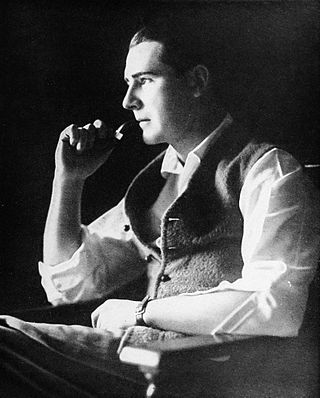
Rex Ingram was an Irish film director, producer, writer, and actor. Director Erich von Stroheim once called him "the world's greatest director".
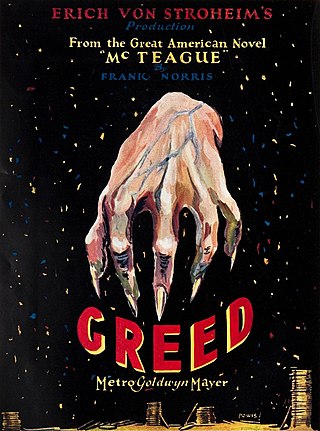
Greed is a 1924 American silent psychological drama film written and directed by Erich von Stroheim and based on the 1899 Frank Norris novel McTeague. It stars Gibson Gowland as Dr. John McTeague; ZaSu Pitts as Trina Sieppe, his wife; and Jean Hersholt as McTeague's friend and eventual enemy Marcus Schouler. The film tells the story of McTeague, a San Francisco dentist, who marries his best friend Schouler's girlfriend Trina.

Erich Oswald Hans Carl Maria von Stroheim was an Austrian-American director, screenwriter, actor, and producer, most noted as a film star and avant-garde, visionary director of the silent era. His 1924 film Greed is considered one of the finest and most important films ever made. After clashes with Hollywood studio bosses over budget and workers' rights problems, Stroheim found it difficult to find work as a director and subsequently became a well-respected character actor, particularly in French cinema.

William H. Daniels ASC was a film cinematographer who was best-known as actress Greta Garbo's personal lensman. Daniels served as the cinematographer on all but three of Garbo's films during her tenure at Metro-Goldwyn-Mayer, including Torrent (1926), The Mysterious Lady (1928), The Kiss (1929), Anna Christie (1930), Grand Hotel (1932), Queen Christina (1933), Anna Karenina (1935), Camille (1936) and Ninotchka (1939). Early in his career, Daniels worked regularly with director Erich von Stroheim, providing cinematography for such films as The Devil's Pass Key (1920) and Greed (1924). Daniels went on to win an Academy Award for Best Cinematography for his work on The Naked City (1948).
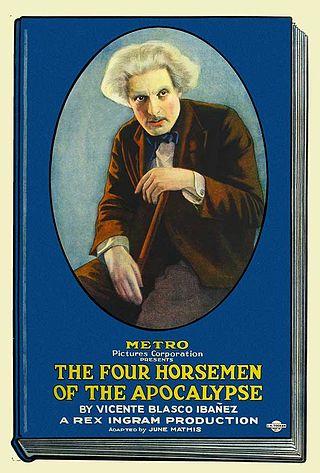
The Four Horsemen of the Apocalypse is a 1921 American silent epic war film produced by Metro Pictures Corporation and directed by Rex Ingram. Based on the 1916 Spanish novel The Four Horsemen of the Apocalypse, by Vicente Blasco Ibáñez, it was adapted for the screen by June Mathis. The film stars Pomeroy Cannon, Josef Swickard, Bridgetta Clark, Rudolph Valentino, Wallace Beery, and Alice Terry.

The Mask of Diijon is a 1946 American black-and-white horror noir suspense film released from PRC Studios, directed by Lew Landers and featuring Erich von Stroheim, Jeanne Bates and William Wright.

Denise Vernac, was a French film actress. She appeared in seventeen films, between 1939 and 1966.
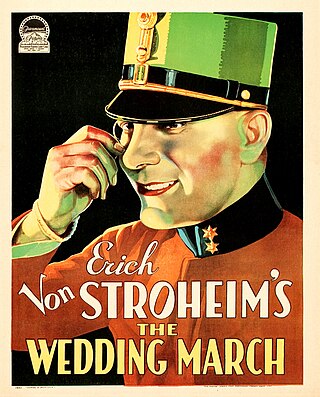
The Wedding March is a 1928 American synchronized sound romantic drama film written and directed by Erich von Stroheim. While the film has no audible dialog, it was released with a synchronized musical score with sound effects using both the sound-on-disc and sound-on-film process. The film stars Erich von Stroheim, Fay Wray and ZaSu Pitts. Paramount Pictures forced von Stroheim to create two films from the footage, the second being The Honeymoon. The Honeymoon is now considered lost, the only known copy destroyed in a fire in France in 1959.
The Dance of Death refers to two plays, The Dance of Death I, and The Dance of Death II, both written by August Strindberg in 1900. Part one was written in September, and then, after receiving a response to the play, part two was written in November. The two plays have much in common, and each is a full evening in the theatre. If they are joined together as one theatre-going experience, a couple of unexplained discrepancies between the two plays present difficulties. For example, in part one the Captain is desperately poor, and in part two he is well-to-do.

Alraune, later renamed Unnatural: The Fruit of Evil, is a 1952 West German horror science fiction film, directed by Arthur Maria Rabenalt and starring Hildegard Knef and Erich von Stroheim. The film is based on the 1911 novel Alraune by German novelist Hanns Heinz Ewers. The plot involves a scientist who creates a woman (Knef) who is beautiful yet soulless, lacking any sense of morality.

The Merry Widow is a 1925 American silent romantic drama/black comedy film directed and written by Erich von Stroheim. Released by Metro-Goldwyn-Mayer, the film stars Mae Murray, John Gilbert, Roy D'Arcy, and Tully Marshall, with pre-fame uncredited appearances by Joan Crawford and Clark Gable.

Foolish Wives is a 1922 American erotic silent drama film produced and distributed by Universal Pictures under their Super-Jewel banner and written and directed by Erich von Stroheim. The drama features von Stroheim, Rudolph Christians, Miss DuPont, Maude George, and others.
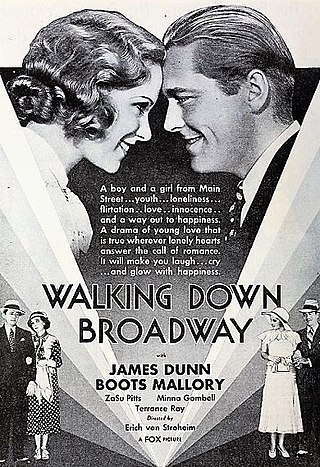
Hello, Sister! is a 1933 American pre-Code drama-romance film produced by Fox Film Corporation. It was directed by Erich von Stroheim, Raoul Walsh, Alfred L. Werker, and Edwin Burke, although none of those directors are credited. The film is a re-edited version of von Stroheim's now-lost film Walking Down Broadway.
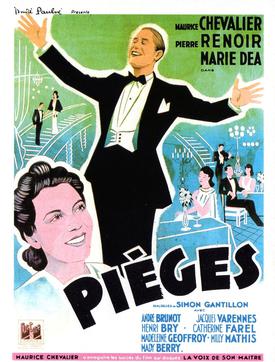
Personal Column is a 1939 French thriller film directed by Robert Siodmak and starring Maurice Chevalier, Pierre Renoir, Marie Déa and Erich von Stroheim. It was shot at the Joinville Studios in Paris. The film's sets were designed by the art directors Maurice Colasson and Georges Wakhévitch. Lured, an American re-make, directed by Douglas Sirk and starring Lucille Ball, was released in 1947.

Madonna of the Sleeping Cars is a 1955 French drama film directed by Henri Diamant-Berger and starring Giselle Pascal, Jean Gaven and Erich von Stroheim. The film is an adaptation of the 1925 novel of the same title by Maurice Dekobra, though the plot has been changed somewhat, and the action brought into the 1950s and set in Latin America rather than the Black Sea coast of the USSR.

Immediate Call, is a 1939 French comedy drama film, directed by Léon Mathot and starring Mireille Balin, Roger Duchesne, Erich von Stroheim, and Bernard Lancret. The plot is about a hosted peace conference, that results in saving the world.

The Other Side of Paradise is a 1953 French drama film directed by Edmond T. Gréville and starring Erich von Stroheim, Jacques Sernas and Denise Vernac. Much of the film was shot on location in Provence. The film's sets were designed by the art director Jean Douarinou.
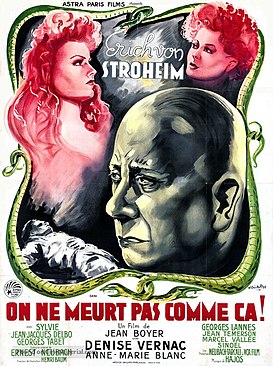
That's Not the Way to Die is a 1946 French mystery crime film directed by Jean Boyer and starring Erich von Stroheim, Anne-Marie Blanc and Denise Vernac. The film's sets were designed by the art director Aimé Bazin. It borrows its main plot device from the 1932 American film The Death Kiss. von Stroheim was not happy with the film, but felt it received good reviews and was popular with audiences.

Threats is a 1940 French drama film directed by Edmond T. Gréville and starring Mireille Balin, John Loder, Ginette Leclerc and Erich von Stroheim. Gréville began production on the film shortly after the Munich Agreement of September 1938. It was shot at the François 1er Studios in Paris. The film's sets were designed by the art director Lucien Jaquelux.
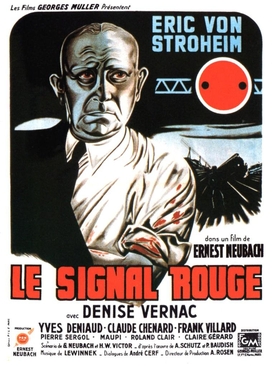
The Red Signal is a 1949 French drama film directed by Ernst Neubach and starring Erich von Stroheim, Denise Vernac and Frank Villard. It is based on a novel of the same title by Adolf Schütz and Paul Baudisch. It was shot at the Victorine Studios in Nice. The film's sets were designed by the art director Louis Le Barbenchon.



















